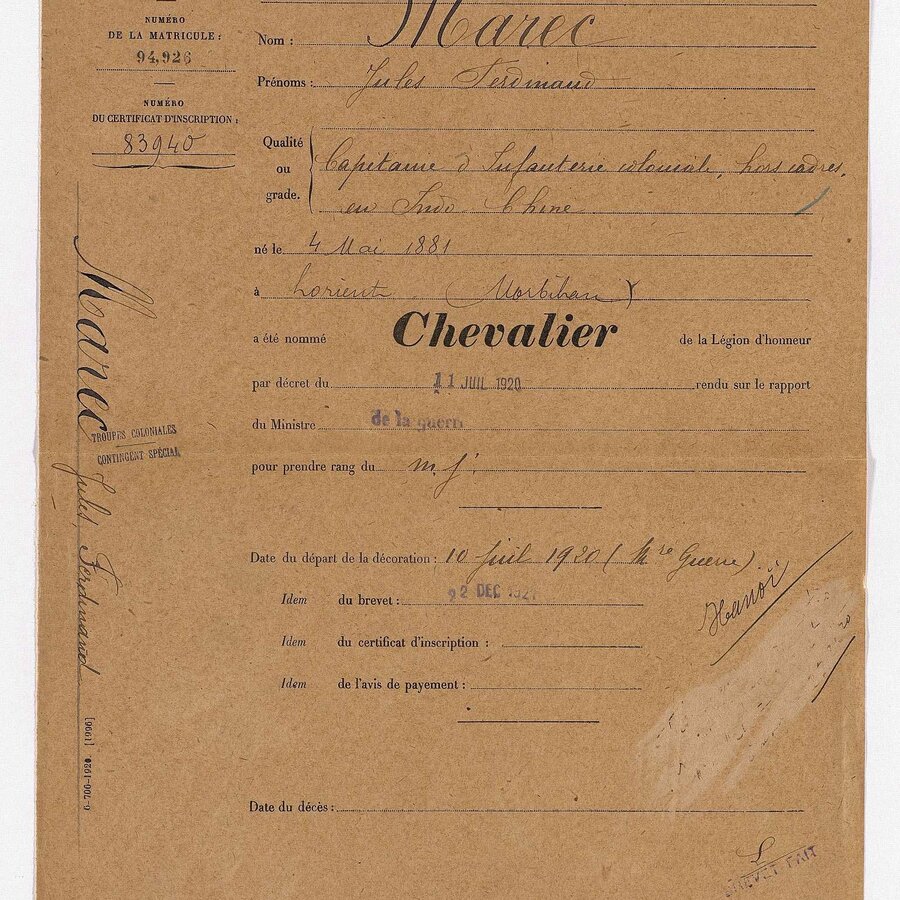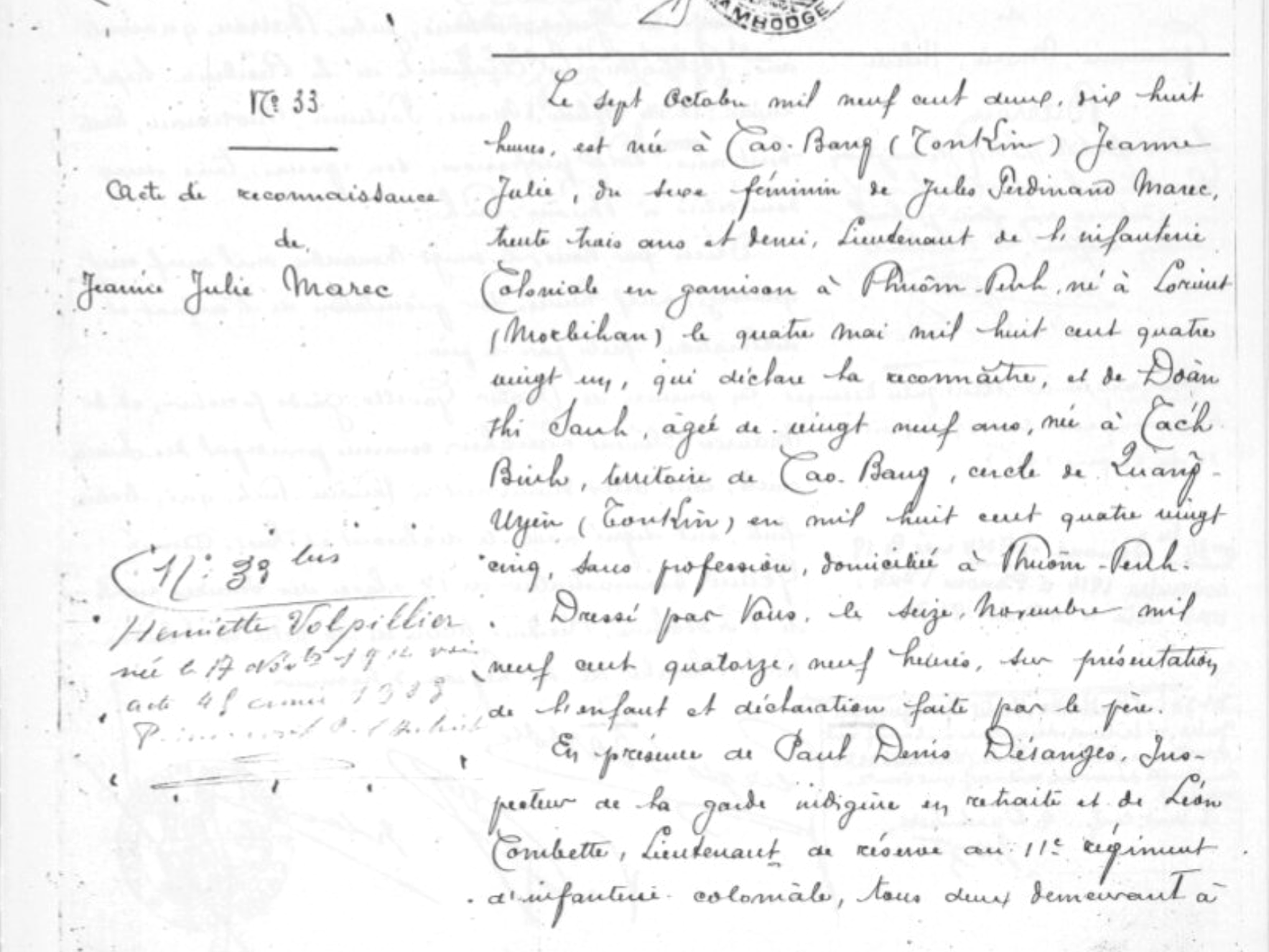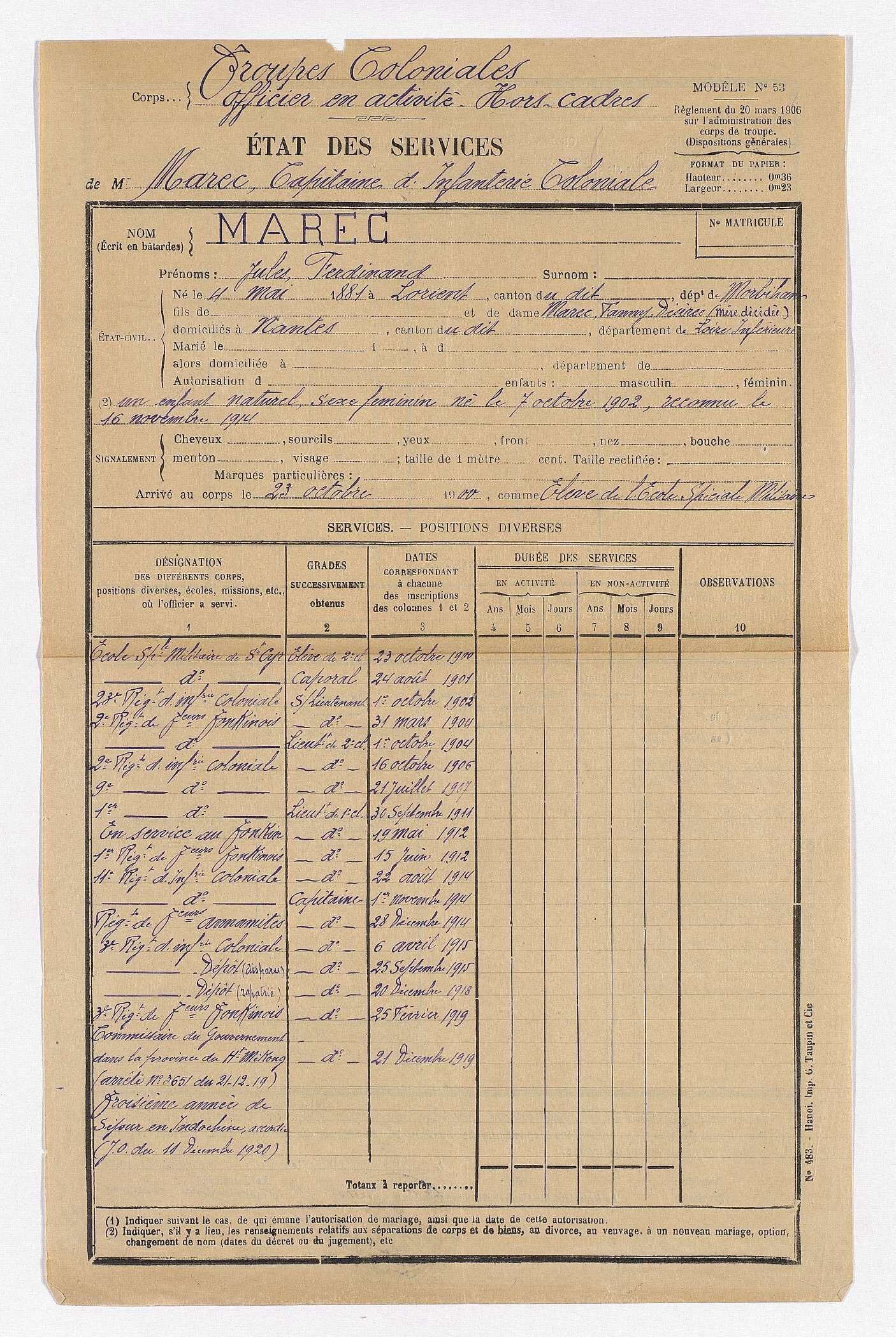Jules Ferdinand Marec

Jules Ferdinand Marec (4 May 1881, Lorient, France — 13 March 1957, Saint-Sauveur-Sur-Ecole, Seine et Marne, France) was a French military cartographer and explorer who was the first to survey the site of Banteay Srei in January 1914, and sent two statues and stone elements from the temple to Phnom Penh Musée Albert-Sarraut (now National Museum of Cambodia).
Bearing the name of his mother, Fanny Désirée Marec (who recognized him as “fils naturel” on 24 March 1894), he was a gifted student at Nantes public high school Lycée Clémenceau — with distinctions in algebra, geometry, history, geography, physics, chemistry [1] — entered Saint-Cyr French military school on 23 Oct 1900 and joined the 23th Colonial Infantry Regiment on 24 Aug 1901. A member of the Service Géographique de l’Indochine (Geographical Survey of Indochina, GIS), he was promoted from corporal and lieutnant to captain in November 1914. He was made Chevalier de la Légion d’Honneur on 11 July 1920, and Officier de la Légion d’Honneur on 4 April 1954.
From 1919 to 1924, Marec was Commissaire du gouvernement de la Province du Haut-Mekong in Laos, and was appointed on 12 Jan 1921 as “gestionnaire du compte-courant” in Muong Sing [Bulletin administratif du Commissariat de la République française au Laos, 1st January 2021]. Later, he followed on with his cartographic work in the highlands bordering modern Laos, Vietnam and Cambodia, as mentioned in Rapports au Conseil de gouvernement, Gouvernement général de l’Indo-Chine, May 1925 : “Topographie au 80.000° — La première tranche du programme de 1924 a été presque entièrement réalisée. Une Brigade a terminé le levé des feuilles 150 et 158 (Bong-son et Phu-my) pour la partie de ces feuilles actuellement accessibles (limite des régions Sédangs insoumises). Une seconde brigade a achevé le levé des feuilles 203 et 213 (Dalat et Djiring); il a été reconnu, dès le début de la campagne, qu’on né pouvait se contenter des levés semi-réguliers sur toute la surface de ces feuilles. Les environs de Dalat, de Drau, de Djiring notamment, appelés à voir se développer, ultérieurement la colonisation européenne et annamite, ont été exécutés en levés réguliers. Les difficultés qui étaient à craindre de la part des populations mois, mal soumises, de l’ouest du Lang-bian, né se sont pas produites, et le levé semi-régulier de cette région de plus de 1000 km² est en voie d’achèvement; il faut en attribuer le mérite au tact et à la parfaite connaissance des indigènes du chef de Brigade (Commandant Marec) et de l’opérateur (Lieutenant Michelin) qui en étaient chargés. Les plus gros obstacles rencontrés dans le levé de ces deux feuilles sont venus du climat particulièrement pluvieux et paludéen, qui a soumis les opérateurs à une très rude épreuve.” [“Topography at 80,000° — The first phase of the 1924 program has been almost entirely completed. One brigade has completed the survey of sheets 150 and 158 (Bong-son and Phu-my) for the part of these sheets currently accessible (limit of rebellious Sédang regions). A second brigade completed the survey of sheets 203 and 213 (Dalat and Djiring); it was recognized, from the start of the campaign, that we could not be satisfied with semi-regular surveys over the entire surface of these sheets. The surroundings of Dalat, Drau, Djiring in particular, expected to see the subsequent development of European and Annamite colonization, were carried out in regular surveys. The difficulties which were to be feared on the part of the local populations, badly submitted, from the west of Lang-bian, have not occurred, and the semi-regular survey of this region of more than 1000 km² is nearing completion; credit must be given to tact and perfect knowledge of the natives of the Brigade leader (Commander Marec) and the operator (Lieutenant Michelin) who were in charge. The biggest obstacles encountered in the survey of these two sheets came from the particularly rainy and malarial climate, which subjected the operators to severe test.]
In 1926, he was “Brigade Chief based in Chua Chan”. (today Chứa Chan, Dong Nai Province, Vietnam), then retired from the GIS in 1928. From then to his death in 1957, we are looking for information.
On 16 Oct 1902, Marec recognized in Phnom Penh as Jeanne Julie Marec the daughter a Vietnamese woman, Doan Thi Sanh, had given birth to on 7 Oct 1902 in Cao Bang (then Tonkin). He married Thi Sanh in Song Cau (then Annam) on 7 Oct 1923. Jeanne Julie Marec, who had married Pierre Eloi Bernasseau, died in Marseille, France, on 2 Nov 1934.
[1] Information shared with us in January 2024 by Jean Louis Liters, Président du Comité d’Histoire du Lycée Clémenceau de Nantes. Mr. Liters noted that with Marec in the 1900 Saint Cyr promotion was Guy de Chateaubriant, a son of French poet Alphonse de Chateaubriant.
[Thanks to Lia Genovese for pointing out several lines of biographical inquiry to us].


